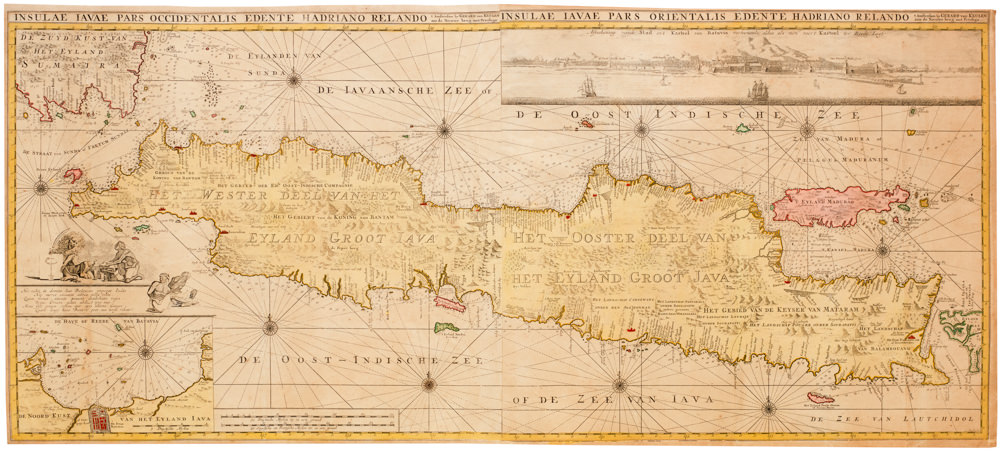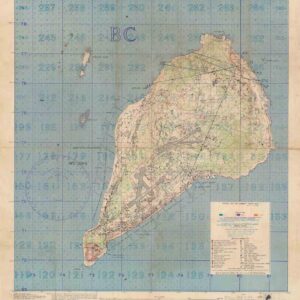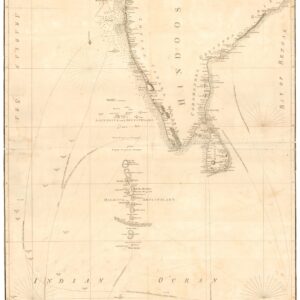Excellent old color example of Willem Blaeu’s seminal map of Asia — one of the 17th century’s most influential depictions of this cartographically complicated continent.
Asia Noviter Delineata.
$2,800
1 in stock
Description
Listen to Kristoffer discuss this map:
Willem Janszoon Blaeu’s stylized map of Asia is a true product of the early 17th century; an age in which our understanding of the world’s geography grew on an almost daily basis. In addition to depicting a highly contested and commercially important region of the world, the map also continues the overall trend of replacing the rigid and schematic world view of Ptolemaic geographers with a more modern, observation-based cartography.
The 16th century was an age of exploration. Asia had been known to Europeans for centuries, in part due to the incredible reports from Marco Polo, but it was not until 1498 , when Vasco da Gama reached India by rounding the Cape of Good Hope, that the maritime route to Asia was opened to the Portuguese. This changed European activity in the Indian Ocean dramatically and also helped shift power within Europe itself. Over the course of the 16th century, numerous expeditions were sent into the Indian Ocean with a combined mission of exploration and trade. Nevertheless, by the time Blaeu was compiling this incredible chart things had shifted again, and the Dutch increasingly dominated these waters. Blaeu’s map was drawn directly into this context, so that it not only sought to provide a more accurate and up-to-date depiction of Asian geography, but also presented Asia as the playground for Dutch merchants.
The latter was not an erroneous claim. The Dutch were extremely competent traders aided by a very liberal economic policy back home, and the Dutch trading houses made vast fortunes via the Asian trade during these years. The spice trade especially became lucrative and saw the Dutch establish themselves as overlords throughout most opt the Indonesian Archipelago. This also meant that while Blaeu may have put as much effort into other continental maps (hyperlink to Africa), to the Dutch, Asia was indubitably the most important region for them to control. This priority is reflected in the composition of the map: Blaeu’s chart was simply the most comprehensive and detailed of the continent to date.
Fabulous cartes-à-figures and city views bring the map to life
As with Blaeu’s other continental maps from the early to mid- 17th century, the Asia map is framed by a series of important vignettes. Along the flanks of the map we find ten images depicting various peoples of Asia. These were primarily the people that Europeans either traded with or had heard about, and it was thus a means of embedding 17th century maps with a degree of ethnographic knowledge as well. Moving from the top left we find Syrians, Arabians, Armenian Persians, Balaguatans (southwest coast of Indian Subcontinent), Sumatrans, Javanese, Moluccans and Bandans, Chinese, Moscovites, and Tartars. The selection consists both of peoples specifically pertinent to Dutch mercantile and colonial efforts (e.g. Chinese, Arabian, and especially Indonesian peoples), as well as more generally known groups such as the Tartars or Syrians.
A second bar of nine vignettes runs along the top of the map and completes its visual framing. These are urban vistas of the major cities of Asia (at least as the Dutch saw it) and include, from left to right, Candy, Calcutta, Goa, Damascus, Jerusalem, Hormusz, Bantam, Aden, and Macao. While a few of these places may have been included for purely symbolic or religious reasons (i.e. Damascus and Jerusalem), the majority of the vistas constitute direct references to coastal emporia and major hubs of European trade. We are in other words not in doubt about where European interests lie at this stage.
Blaeu’s influences and innovations
Asia had been mapped for centuries when Blaeu published this map, but these early charts were based almost exclusively on the 2nd century accounts of Claudius Ptolemy and were thus riddled with error and myth. As Europeans broke into the Indian Ocean, it soon became clear that the Ptolemaic understanding was unreliable. Core elements in maps of Asia dating to the 15th and early 16th century — such as the extensive Malay Peninsula know as the ‘Dragon’s Tail’ — were gradually amended or removed as cartographers replaced Antiquity’s sources with new and verifiable observations.
Holding the position of Chief Hydrographer to the powerful Dutch East India Company (VOC), Blaeu was in an ideal position to propel the revisionist approach. The VOC archives were perhaps the most world’s most comprehensive collection of records and maps pertaining to Asia at the time. The Portuguese had previously dominated these waters, but by the time Blaeu was working, the Dutch had only managed to break their monopoly, but also usurp many of their navigational insights and documents. Blaeu was therefore uniquely capable of setting entirely new standards for the mapping of Asia.
Blaeu’s map has a number of extremely interesting cartographic features that have helped set this map apart from its contemporaries. Some of these are highly characteristic for the period in question, and drawing attention to them is really all about highlighting the elements that one might term archetypal for the age of exploration. These include decorative elements such as the ships and sea monsters dominating the maritime space, as well as more informative imagery on land, for example the depiction of the Great Wall of China or the sporadic fauna shown (i.e. an elephant in near Lake Chismay – the mythical source of the Ganges, a domesticated camel in China, and a slightly faded lion in the northeast corner of Africa). Yet in our opinion, the attributes that really matter on this map are the actual geographic depictions. Note for example the extensive plotting of islands in the southern Indian Ocean. These reflect an overwhelming number of exploratory expeditions in the wake of Da Gama and demonstrate just how keenly aware certain European powers were of the commercial opportunities that lay in understanding and controlling the route there.
Korea as an island and other inaccuracies
Other important cartographic elements to note include the fact that Korea has been depicted as an island. Virtually nothing was known about this region when Blaeu was compiling his map. A Jesuit friar had visited Korea as part of a Japanese invasion in 1592, but his accounts provided very little information, other than the fact that he found the region bitterly cold. Other Jesuits wrote about Korea even earlier, stressing that while it had been interpreted by some as an island, it was in fact a peninsula (Father Luis Frois, 1578). Marco Polo was the first European to mention Korea, naming it Cauli, but providing very little relevant information for mapmakers. By the 16th century, cartographers like Ortelius, Mercator, and Münster would often avoid dealing with the issue by omitting Korea altogether.
The first European cartographers to depict Korea were the Dutch, and the very first seems to have been Peter Plancius. In his 1594 map of East Asia, he depicts Korea as an elongated peninsula barely attached to the Chinese mainland. This understanding was copied in Richard Hakluyt’s Principal Navigations. A year later, in 1595, the seminal Itinerario by Jan Huygens van Linschoten was published. Linschoten had served the Portuguese Vice-roy in Goa for years and had personally sailed on many of the regions he depicts in his maps. For Korea, he nevertheless relied on a map by Arnold Floris van Langgren, who depicted Korea as sizable, round island. The same year, Ortelius went out on a limb by relying on a manuscript map by Luis Teixeira, who also depicted Korea as an island. This confusion about the true nature of Korea continued throughout the 17th century, and from this map we see that Blaeu preferred the Linschoten/Teixeira model over the Plancius/Langgren model.
Other and perhaps more surprising inaccuracies are found within the Indonesian Peninsula, in particular along the eastern side of Borneo. Unlike Korea, this was an area that was heavily sailed upon by the Dutch. The Dutch East India Company was established back in 1602 and by the 1620s they controlled much of the trade with Java, Sumatra, and the so-called Spice Islands. The VOC had spearheaded several colonial settlements in this region, leading a permanent Dutch presence here. Even so, Dutch interests were quite focussed on specific clusters of islands, leaving them largely ignorant of regions immediately adjacent to these.
A final note should be made on the presence of a sliver of North America (America Pars) in the upper right corner of the map, and the labelling of the strait separating it from Asia. This is essentially a depiction of the Northwest Passage prior to any verifiable expeditions into this region. As a cartographic concept, the term “Fretium Anian”, or the Strait of Anian, dates back to at least 1562, where it appears on a map issued by Giacomo Gastaldi. Within a few years, it begins to figure on maps by other famous cartographers such as Ortelius, Zaltieri, and Mercator. The concept’s popularity in cartographic circles can probably be traced back to the late 16th century, when a Greek navigator, Ioánnis Phokás, supposedly was sent north from New Spain (twice no less) in 1592. His goal was to find and map this mythical Strait of Anian. Following the American coastline for more than twenty days, he finally reached the northern cusp of the continent. His story was eventually was published in Samuel Purchas’ travel collection of 1625, cementing the term (though not the credibility of the report). For the next hundred years or so, the Anian concept and term is applied to maps in a plethora of different ways – including as a name for Alaska itself. It was not until the Second Kamchatka Expedition under Vitus Bering (1733-43) that the strait was actually surveyed and mapped.
In sum, Willem Janzoon Blaeu’s map of Asia is one the great decorative charts from the Golden Age of Dutch exploration and mapmaking. It is marvelous testament to the age of discovery and the underlying ambitions of colonialism; not to mention a wonderful manifestation of Dutch ingenuity in mapmaking.
Census and publication
Neatline’s copy is the second state of Blaeu’s Asia map. The first state included the author’s name as Guil. Janssonio, whereas in the second state it was changed to Guiljelmo Blaeuw. The second state was originally published in the 1620s as a separate sheet, but in 1630 Blaeu included it in his first world atlas, the Atlantis Appendix. Years later, his son Joan Blaeu reprinted it in his famous Atlas Maior. Consequently, this map was produced in sufficient copies to figure in many institutional collections.
Cartographer(s):
Willem Janszoon Blaeu (1571-1638) was one of the most important Dutch geographers and mapmakers of the 17th century. He was born the son of a herring merchant but traded fishmongering for studies in mathematics and astronomy. Blaeu’s first important breakthrough was winning an apprenticeship with the famous Danish astronomer Tycho Brahe. Working at Brahe’s Uranienborg observatory on the island of Hven, Blaeu learned various disciplines and technical skills. These included mathematics, astronomy, instrument-making, and more esoteric disciplines such as alchemy. Returning to his native Holland, Blaeu established a publishing business in Amsterdam. He sold instruments and globes, printed maps, and his own editions of some of the great philosophical works of contemporary intellectuals like Descartes and Hugo Grotius. Achieving notoriety as a cartographic pioneer, Blaeu was appointed Chief Hydrographer to the powerful Dutch East India Company, a position he held until he died in 1638.
When Willem died, his sons Cornelis (1610-1648) and Joan (1596-1673) took over the business. Joan had originally trained as a lawyer but never took up the practice, preferring to work on maps with his father. After Willem’s death, Joan continued publishing his father’s and his own maps. He also assumed his father’s position as a hydrographer for the Dutch East India Company. Towards the end of his life, Joan would dramatically expand his father’s Atlas Novus (1635), turning it into his own masterpiece, the Atlas Maior (1662-72).
When Willem died, his two sons Cornelis (1610-1648) and Joan (1596-1673) took over the business. Joan had originally trained as a lawyer, but never took up practice, preferring to work on maps with his father. After Willem’s death, Joan continued to publish both his father’s and his own maps. He also assumed his father’s position as hydrographer for the Dutch East India Company. Towards the end of his life, Joan would dramatically expand his father’s Atlas Novus (1635), turning it into his own masterpiece, the Atlas Maior (1662-72).
Condition Description
Original color. some discoloration, minor wear along fold line; edges darker
References
References: Van der Krogt 2, 8000:2; Schilder 6, 21:2; Yeo (Asia), 24.



![[Cook’s Discovery of Eastern Australia] Carte de la Nle. Galles Merid. ou de la Cote Oriental de la Nle. Hollande.](https://neatlinemaps.com/wp-content/uploads/2021/12/NL-01183_Thumbnail-300x300.jpg)
![[Cook’s Discovery of Eastern Australia] Carte de la Nle. Galles Merid. ou de la Cote Oriental de la Nle. Hollande.](https://neatlinemaps.com/wp-content/uploads/2021/12/NL-01183_Thumbnail.jpg)

